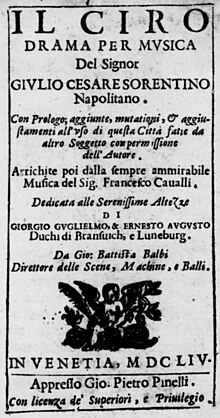
Francesco Cavalli was a Venetian composer, organist and singer of the early Baroque period. He succeeded his teacher Claudio Monteverdi as the dominant and leading opera composer of the mid 17th-century. A central figure of Venetian musical life, Cavalli wrote more than forty operas, almost all of which premiered in the city's theaters. His best known works include Ormindo (1644), Giasone (1649) and La Calisto (1651).
Francesco Provenzale was an Italian Baroque composer and teacher. He is considered the founder of the Neapolitan school of opera. Notably Provenzale was the teacher of famed castrato 'il cavaliere Nicolo Grimaldi '.
This is a list of music conservatories in Naples, Italy.
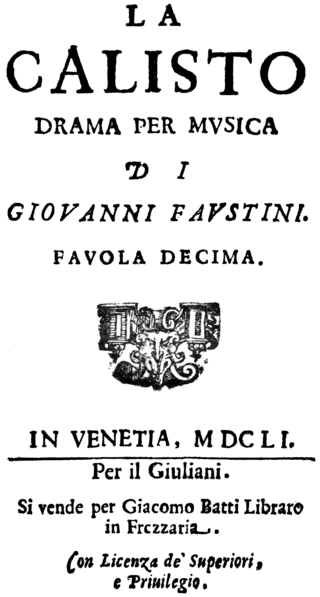
La Calisto is an Italian opera by Francesco Cavalli from a libretto by Giovanni Faustini based on the mythological story of Callisto.
The year 1654 in music involved some significant events.

Anna Renzi was an Italian soprano renowned for her acting ability as well as her voice, who has been described as the first diva in the history of opera.

Didone is an opera by Francesco Cavalli, set to a libretto by Giovanni Francesco Busenello. The opera was first performed at Venice's Teatro San Cassiano during 1640.
Count Nicolò Minato was an Italian poet, librettist and impresario. His career can be divided into two parts: the years he spent at Venice, from 1650 to 1669, and the years at Vienna, from 1669 until his death.
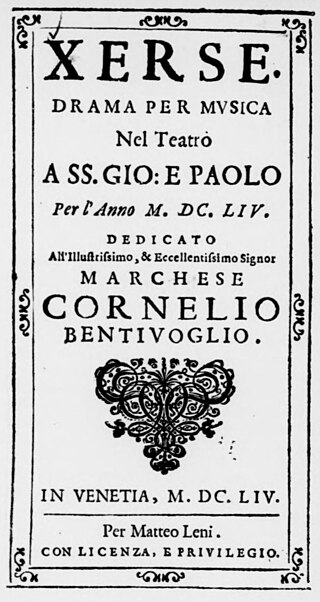
Il Xerse, usually written Xerse, is an Italian opera by Francesco Cavalli about Xerxes I. The libretto was written by Nicolò Minato and was later set by both Giovanni Bononcini and George Frideric Handel. Minato's plot outline is loosely based on Book 7 of Herodotus's Histories. The opera, consisting of a prologue and three acts, was composed in 1654 and first performed on 12 January 1655 at the Teatro SS. Giovanni e Paolo in Venice. It was dedicated to the Ferrarese nobleman Marchese Cornelio Bentivoglio.

Statira principessa di Persia is an opera – more specifically, a dramma per musica – in a prologue and three acts by Francesco Cavalli, set to a libretto by Giovanni Francesco Busenello. The opera was first performed in Venice at the Teatro SS. Giovanni e Paolo, on 18 January 1656.

Giovanni Francesco Busenello was an Italian lawyer, librettist and poet of the 17th century.

Xerse (Xerxes) is an opera in three acts by Giovanni Bononcini. It was designated as a dramma per musica. The libretto was written by Silvio Stampiglia after that by Nicolò Minato which had been used for the 1654 opera of the same name by Francesco Cavalli. Stampiglia's version was in turn used as the basis for Handel's Serse.

Hipermestra is an opera in a prologue and 3 acts by Francesco Cavalli - more specifically, it is a festa teatrale. The opera was set to a libretto by G. A. Moniglia, and was first performed at Florence on 12 June 1658. The plot is based upon the ancient tale of Hypermnestra, a story that also later served as a basis for a well-known libretto Ipermestra by Metastasio. It was staged several times up to 1680.
Giovanni Faustini was an Italian librettist and opera impresario of the 17th century. He is best remembered for his collaborations with the composer Francesco Cavalli.

Artemisia is an opera in three acts and a prologue by the Italian composer Francesco Cavalli from a libretto written by Nicolò Minato. It was first performed at the Teatro San Giovanni e San Paolo, Venice on 10 January 1657 and revived in Naples in 1658, Palermo in 1659, Milan in 1663 and Genoa in 1665.
Giacinto Andrea Cicognini (1606–1651) was an Italian playwright and librettist, the son of poet and playwright Jacopo Cicognini.

The Teatro Santi Giovanni e Paolo was a theatre and opera house in Venice located on the Calle della Testa, and takes its name from the nearby Basilica of Santi Giovanni e Paolo, Venice. Built by the Grimani family in 1638, in its heyday it was considered the most beautiful and comfortable theatre in the city. The theatre played an important role in the development of opera and saw the premieres of several works by Francesco Cavalli, as well as Monteverdi's Il ritorno d'Ulisse in patria and L'incoronazione di Poppea.
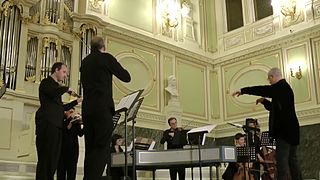
Cappella Neapolitana is an early music ensemble based in Naples and dedicated to the recovery of Neapolitan musical heritage, primarily from the baroque era.
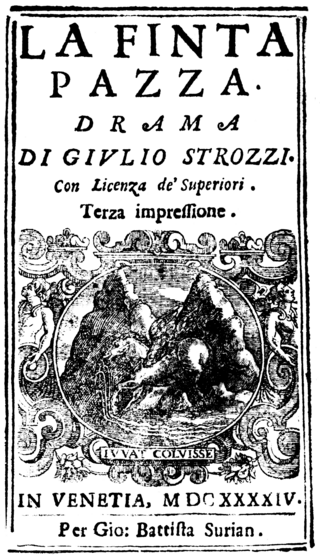
La finta pazza is an opera composed by Francesco Sacrati to a libretto by Giulio Strozzi. Its premiere in Venice during the Carnival season of 1641 inaugurated the Teatro Novissimo. It became one of the most popular operas of the seventeenth century.
Dinko Fabris is an Italian musicologist. He specializes in lute music, the music of Naples, and Italian music in general, having written books on Italian composers such as Andrea Falconieri, Andrea Gabrieli, Francesco Provenzale and Francesco Cavalli. He holds teaching posts at the Conservatory of Bari and the University of Basilicata, and was president of the International Musicological Society from 2012 to 2017.
